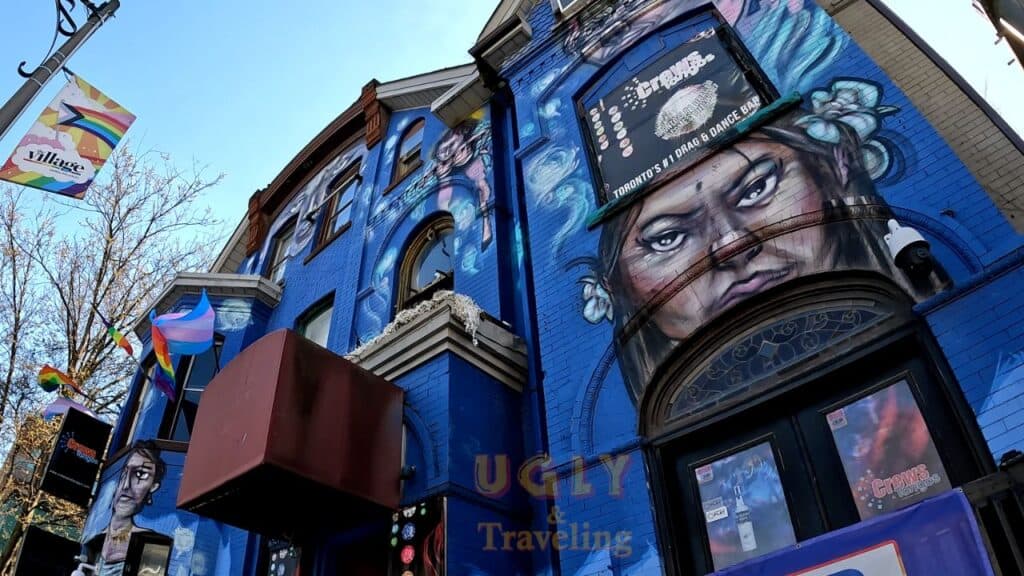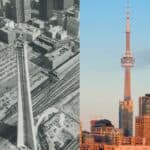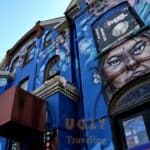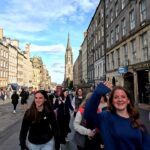Toronto’s Gay Village, nestled at the intersection of Church and Wellesley Streets, has become an iconic destination for LGBTQ+ individuals from far and wide. This vibrant neighborhood offers a welcoming space for people to explore their identity, sexuality, and expression without fear of judgment. But, it wasn’t always this way.
Discover Toronto’s Gay Village, a vibrant hub of resilience & pride! From scandal to celebration, uncover the secret history of this iconic neighborhood & find out how it became a beacon of hope & inclusivity in the heart of the city.
In this article, we’ll delve into the rich history of Toronto’s Gay Village and its transformation into the thriving community it is today. Let’s dive in!
A Supportive Community in the Heart of the City
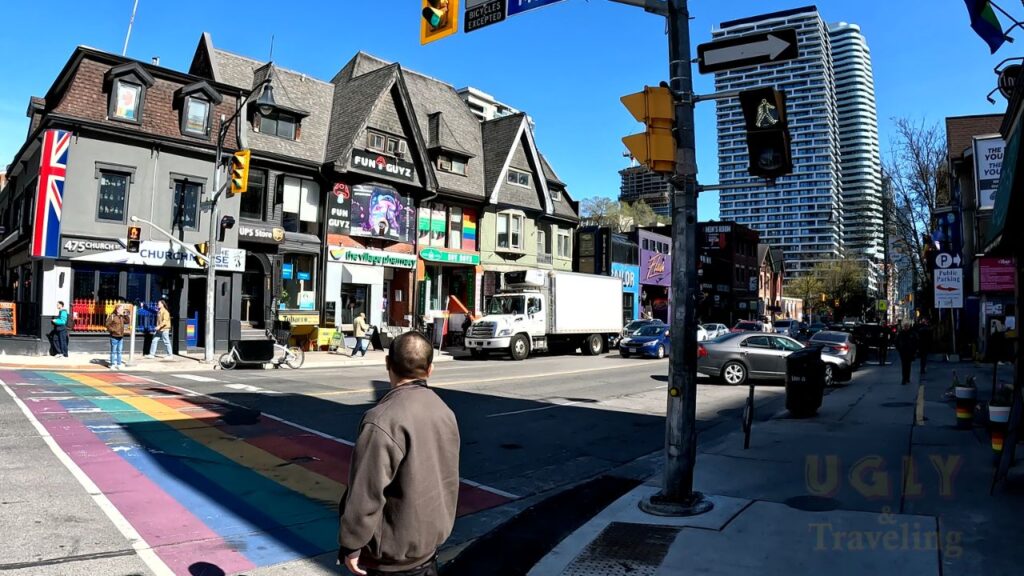
The Village is a unique blend of small-town charm and urban excitement. With its convenient location and transit connections, it’s an ideal destination for those seeking the best of both worlds. The neighborhood is home to cutting-edge businesses, events, and cultural attractions that contribute to the city’s vibrant urban landscape.
A Hub for Art, Culture, and Entertainment
Art and culture are at the heart of The Village’s lifestyle. You’ll find an array of galleries, art installations, and theaters showcasing local talent and creativity. When the sun goes down, the nightlife comes alive with diverse music, dancing, and shows that attract visitors from all over.
A Historic Haven for LGBTQ+ Communities
For decades, The Village has been a beacon for LGBTQ+ individuals seeking a sense of community and belonging. It remains a primary gathering place for tourists and newcomers to the city, offering a welcoming space to connect and express themselves freely.
Celebrating Pride and Diversity
As an award-winning community, The Village takes pride in hosting Toronto’s Pride Festival, a joyous celebration of the neighborhood’s history, diversity, and resilience. A place where anybody can embrace the spirit of inclusivity and self-expression that makes The Village a truly special place.
The Unlikely Forefather of Toronto’s Gay Village: Alexander Wood
In the 1800s, Alexander Wood, a Scottish-born magistrate and merchant, acquired 25 acres of land in what is now the heart of Toronto’s Gay Village. Little did he know that his legacy would be forever tied to the LGBTQ+ community. Wood’s estate, which spanned from Yonge and Carlton streets to Wellesley and Church streets, was mockingly called “Molly Wood’s Bush” after he was embroiled in a scandal involving alleged sexual advances towards men. The term “molly” was a derogatory term for homosexuals at the time.
Despite the controversy, Wood’s land was developed in the 1850s, and Alexander and Wood streets were born. Fast forward to 2005, a statue of Alexander Wood was erected at Church and Alexander streets, acknowledging him as the forefather of Toronto’s Gay Village.
The Underground Gay Scene of the 19th Century
After the Great Depression, the Church-Jarvis-Sherbourne area underwent a transformation, becoming a trendy neighborhood with prominent residents like businessman Robert Simpson. The 1950s saw the rise of City Park, Toronto’s first high-rise apartments, situated between Alexander and Wood streets.
Church Street and its surroundings have been a safe haven for Toronto’s gay community since the early 19th century. Between 1960 and 1980, an underground male gay scene flourished, with bathhouses, bars, restaurants, and other establishments playing a crucial role in nurturing the burgeoning gay subculture. These hotspots included Parkside Tavern, St. Charles Tavern on Yonge Street, and Allan Gardens.
Initially, most of these establishments were owned by heterosexual individuals but catered to gay men. It wasn’t until the 1970s, when gay-owned businesses started emerging, that the queer subculture truly took hold of Church Street, as commercial spaces became more affordable.
The Turbulent History of Toronto’s Gay Village: Overcoming Adversity and Discrimination
In the 1970s, the Church and Wellesley Village hosted a vibrant Halloween parade, showcasing the community’s creativity and flamboyance. However, this joyful event was marred by homophobic abuse and discrimination, with some spectators egging and insulting drag performers along Yonge Street. The situation escalated, requiring police intervention to maintain control.
The 1981 Toronto Bathhouse Raids: A Turning Point for the Gay Community
On February 5, 1981, the Toronto Gay Village was shaken by the largest single arrest in the city’s history, second only to the 1970s FLQ crisis in Quebec. In “Operation Soap,” 200 police officers raided downtown bathhouses, charging 286 men as found-ins and 20 as operators of common bawdy houses.
The arrested individuals faced excessive police behavior, including verbal taunts about their sexuality, and bathhouse owners reported significant damages. Many of those charged were later found innocent.
A Pivotal Moment for the Gay Community
Driven by outrage and inspired by the 1969 Stonewall riots in New York, the gay community efficiently organized a protest. Over 3,000 people marched from Wellesley and Yonge to Dundas Street, then to 52 Police Division and finally to Queen’s Park.
Longtime activist Dennis Findlay, who was among the protestors and helped those affected by the raids, reflected: “The significance of the bathhouse raids was that it was an attack on the community and human rights to freedom… It brought the community together and politicized the community and individuals in a very significant way – such that when AIDS happened (in the years to come), we were organized and ready, and we understood how to go about organizing around an issue.”
This pivotal moment marked a turning point for the gay community, fostering unity and determination in the face of adversity.
The 519 Community Centre: A Beacon of Hope and Inclusivity in Toronto’s Gay Village
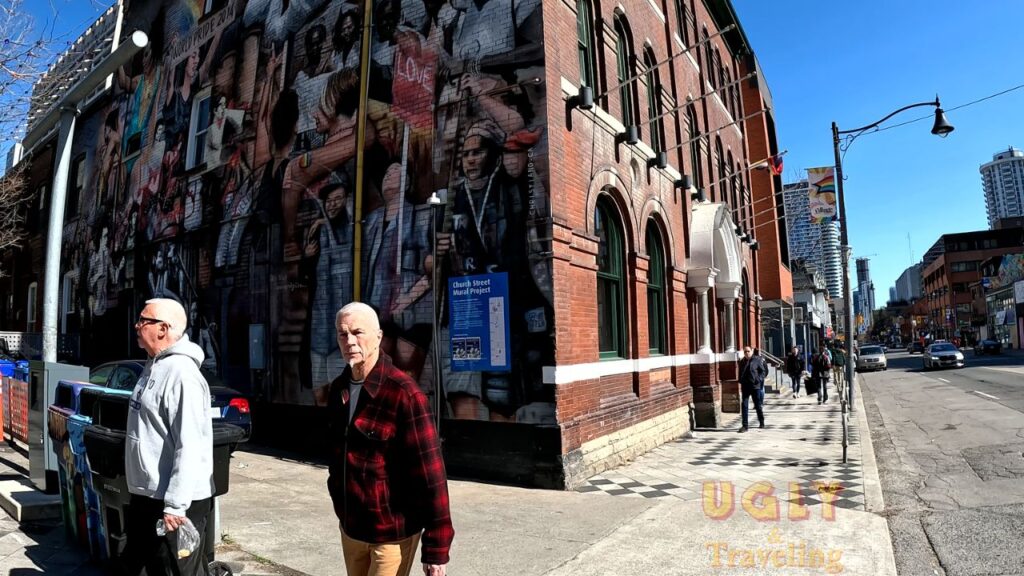
Since its opening in 1975, the 519 Community Centre has been a cornerstone of Toronto’s Gay Village, providing a safe and welcoming space for LGBTQ+ individuals and groups. This community-driven hub has played a significant role in promoting inclusivity, acceptance, and social justice. Let’s take a look at some of the notable milestones in its history:
- 1976: The 519 received its first application from Huntley Youth Services to host gay youth group activities and saw the opening of the original Yuk Yuk’s International Standup Comedy in its basement, featuring talents like Howie Mandel and Jim Carrey.
- 1977: The centre recognized the rights of neighborhood street-active, homeless, or sex workers to use its facilities.
- 1982: In response to the traumatic bathhouse raids, The 519 served as a safe haven for LGBTQ+ advocacy groups, including the Right to Privacy Committee and Gaycare.
- 1984: The Hassle-Free Clinic was established, offering free medical and counselling services in sexual health, and Zami, an interactive support group for African Americans and West Indians in the gay community, was founded.
- 1993: The AIDS Memorial was unveiled in Cawthra Park, a result of a program run through The 519.
- 1994: Advocacy groups fighting for equal marriage rights met at The 519 before taking to the streets in protest.
- 1998: The MealTrans Programme was launched, providing nutritious food to low-income trans individuals.
- 2001: The “Families Against Homophobia” curriculum was created in collaboration with the Toronto District School Board.
- 2005: The Anti-Poverty and Homeless Programme served thousands of meals, distributed clothing, and facilitated medical service visits.
- 2015: The 519 became the trustee and host of PrideHouse Toronto, ensuring the 2015 Pan Am/Parapan American Games were the most LGBTQ-inclusive multi-sport Games in history.
The 519 Community Centre has been a constant source of support and solidarity for the LGBTQ+ community, fostering a sense of belonging and promoting social change. Its legacy continues to inspire and empower individuals from all walks of life.
Toronto’s Gay Village: A Queer-Friendly Destination Under Threat
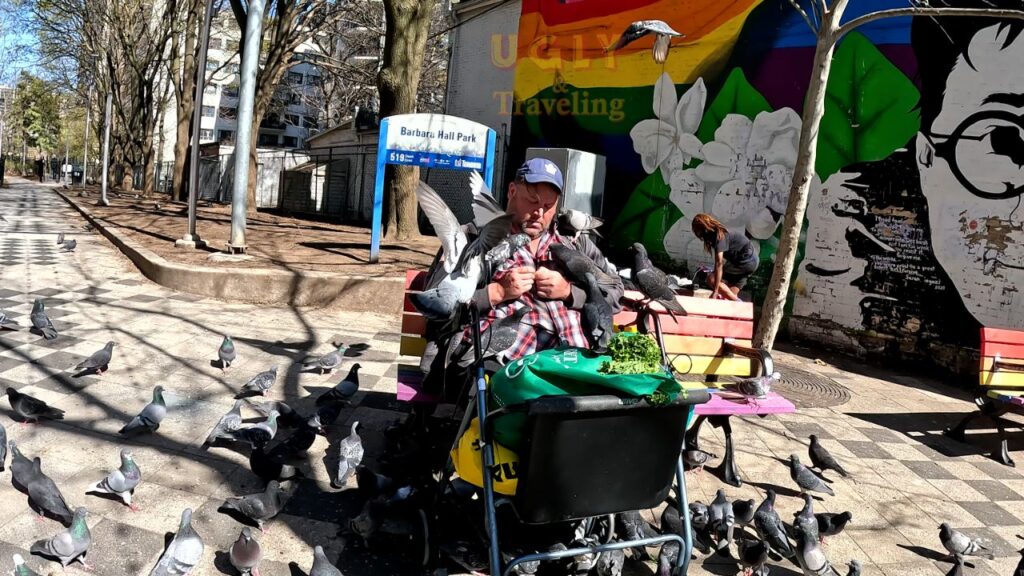
As awareness and acceptance of LGBTQ+ rights grow in Canada, queer-friendly destinations, establishments, and events are emerging in various parts of the city, such as Leslieville, Parkdale, and Queen West. While this progress is welcome, it also poses a threat to the cultural and economic future of the historic Toronto Gay Village.
The neighborhood, once vibrant and thriving, is now facing challenges from:
- Expensive rent
- Condominium developments
- Big-box stores
These factors are squeezing out local, independent, and queer-owned businesses, putting the community’s heritage at risk.
What’s Pride Month Toronto all about?
I think we’ve covered enough history for now. Let’s shift our focus to something vibrant and colorful—Pride Month in Toronto!
You might know that June is Pride Month in many countries around the world. But did you know that Toronto also celebrates Public Service Pride Week every August? And that’s not all – Pride events happen all summer long across Canada!
Every June in Toronto, Ontario, Canada, folks come together for Pride Toronto, a massive celebration of the LGBTQ+ community. It’s one of the biggest pride festivals globally, filled with live music, DJs, and lots of fun. The festival hub is in the Church and Wellesley village, with the parade and marches happening nearby on Yonge Street, Gerrard Street, and Bloor Street. Back in 2014, it even hosted WorldPride, making it bigger than your usual Toronto Pride.
But the big news is that Pride Toronto is bringing back the StreetFair in 2024, If you are in Toronto join the Festival Weekend, from June 28th to 30th, 2024, for a fantastic celebration with local vendors, artisans, and community groups.
If you’re planning a trip to Toronto, don’t miss out on the vibrant energy of the Church and Wellesley village during Pride Toronto. It’s not just a festival; it’s a celebration of love, acceptance, and diversity. Whether you’re part of the LGBTQ+ community or an ally, visiting the village during Pride is an experience you won’t forget. From the lively atmosphere to the powerful sense of community, there’s something truly special about being a part of it all.
Support Queer-Friendly Businesses in Toronto’s Gay Village
If you visit the Toronto Gay Village, be sure to support these queer-friendly businesses:
- Books: Glad Day Bookshop (the world’s oldest queer bookstore!)
- Shopping: Fortune and Strength
- Coffee Shops: Piedmont Coffee Bar, Fuel Plus, and Church Street Espresso
- Nightclubs: Crews and Tangos, Woody’s (best drag shows in town), and Club 120
- Restaurants and Bars: Hair of the Dog, Sambucas on Church, and Storm Crow Manor
My Closing Thoughts
I would say if you’re planning a trip to Toronto, make sure to add the Church and Wellesley Village to your itinerary. This vibrant neighborhood is a must-visit destination, not just for the LGBTQ+ community, but for anyone looking to experience the city’s diversity, inclusivity, and creativity.
From its rich history and cultural attractions to its lively nightlife and eclectic shops, the Village has something for everyone. By visiting the Village, you’ll not only be supporting a community that’s been a beacon of hope and acceptance for decades, but you’ll also be immersing yourself in the heart of Toronto’s spirit.
So come and explore, and let the warmth and welcoming nature of the Village leave you with unforgettable memories of your time in Toronto. You can watch the Village in 4K in my vlog and witness the beautify of this vibrant neighborhood during summer.
Watch in 4K Toronto Downtown | The Village, Church and Wellesley
I hope you enjoyed this insider’s guide to the Village in Toronto! Let me know in the comments below what your favorite things to see and do in the city are. Have you ever been to Toronto? Share your travel experiences with us!
